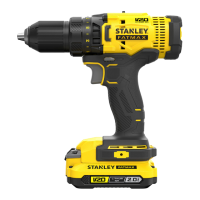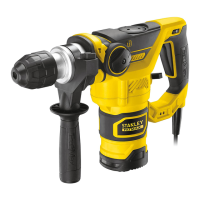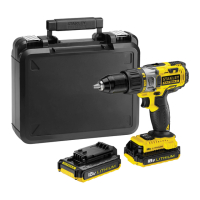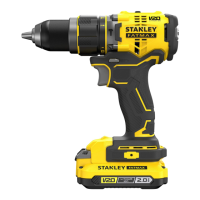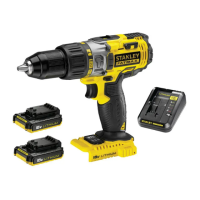6
ENGLISH
(Original instructions)
b. Use power tools only with specically designated
battery packs. Use of any other battery packs may create
a risk of injury and re.
c. When battery pack is not in use, keep it away from
other metal objects, like paper clips, coins, keys,
nails, screws, or other small metal objects, that can
make a connection from one terminal to another.
Shorting the battery terminals together may cause burns
or a re.
d. Under abusive conditions, liquid may be ejected from
the battery; avoid contact. If contact accidentally
occurs, ush with water. If liquid contacts eyes,
additionally seek medical help. Liquid ejected from the
battery may cause irritation or burns.
e. Do not use a battery pack or tool that is damaged or
modied. Damaged or modied batteries may exhibit
unpredictable behaviour resulting in re, explosion or risk
of injury.
f. Do not expose a battery pack or tool to re or
excessive temperature. Exposure to re or temperature
above 130 °C may cause explosion.
Note: The temperature „130 °C“ can be replaced by the
temperature „265 °F“.
g. Follow all charging instructions and do not charge the
battery pack or tool outside the temperature range
specied in the instructions. Charging improperly or
at temperatures outside the specied range may damage
the battery and increase the risk of re.
6. Service
a. Have your power tool serviced by a qualied repair
person using only identical replacement parts.
This will ensure that the safety of the power tool is
maintained.
b. Never service damaged BATTERY packs. Service of
BATTERY packs should only be performed
by the manufacturer or authorized service providers.
Additional power tool safety warnings
@
Warning! Additional safety warnings for screw-
drivers.
u Hold the power tool by insulated gripping surfaces,
when performing an operation where the cutting ac-
cessory may contact hidden wiring. Cutting accessory
contacting a "live" wire may make exposed metal parts
of the power tool "live" and could give the operator an
electric shock.
u Wear ear protectors with impact drilling. Exposure
to noise can cause hearing loss.
u Use auxiliary handles supplied with the tool. Loss of
control can cause personal injury.
u Brace the tool properly before use. This tool produces
a high output torque and without properly bracing the tool
during operation, loss of control may occur resulting in
personal injury.
Safety instructions when using long drill bits
u Never operate at higher speed than the maximum
speed rating of the drill bit. At higher speeds, the bit is
likely to bend if allowed to rotate freely without contacting
the workpiece, resulting in personal injury.
u Always start drilling at low speed and with the bit tip
in contact with the workpiece. At higher speeds, the bit
is likely to bend if allowed to rotate freely without
contacting the workpiece, resulting in personal injury.
u Apply pressure only in direct line with the bit and do
not apply excessive pressure. Bits can bend causing
breakage or loss of control, resulting in personal injury.
u Use clamps or another practical way to secure and
support the work piece to a stable platform. Holding
the work by hand or against your body leaves it unstable
and may lead to loss of control.
u Before driving fasteners into walls, oors or ceilings,
check for the location of wiring and pipes.
u The intended use is described in this instruction
manual.
u The use of any accessory or attachment or
performance of any operation with this tool other than
those recommended in this instruction manual may
present a risk of personal injury and/or damage to
property.
Safety of others
u This tool is not intended for use by persons (including
children) with reduced physical, sensory or mental capa-
bilities, or lack of experience and knowledge, unless they
have been given supervision or instruction concerning use
of the appliance by a person responsible for their safety.
u Children should be supervised to ensure that they do not
play with the appliance.
Residual risks
Additional residual risks may arise when using the tool which
may not be included in the enclosed safety warnings. These
risks can arise from misuse, prolonged use etc.
Even with the application of the relevant safety regulations
and the implementation of safety devices, certain residual
risks can not be avoided. These include:
u Injuries caused by touching any rotating/moving parts.
u Injuries caused when changing any parts, blades or ac-
cessories.
u Injuries caused by prolonged use of a tool. When using
any tool for prolonged periods ensure you take regular
breaks.

